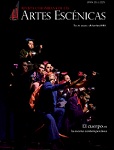Authors
Abstract
On the neutral base of a functional body, the body is reconstructed from movement. The expression of pain is embodied and incorporated in bodies changing tensions and distensions across dynamics that link articulations, nerves and tendons with emotions. This paper suggests a reflection from the perspective of acting and performing about the construction of bodies of pain that derive from violence settings, specifically from social violence, and about the response, from performative arts, in the construction of bodies that change themselves into places of pain that offer at the same time places of memory, recognition and redemption.
References
Bello, M. et al. (2005). Bojayá, memoria y río.Violencia política, daño y reparación. Bogotá:Universidad Nacional de Colombia.
Bernays, J. (1979). Zwei Abhandlungen über die aristotelische Theorie des Drama (1857). Traducido al ingles por Jonathan Barnes y Jennifer Barnes como “Aristotle on the Effect of Tragedy,” en Articles on Aristotle, Vol. 4: Psychology and Aesthetics, eds Jonathan Barnes et al. (London: Duckworth, 1979), 154-65.
Caruth, C. (1996). Unclaimed Experience: Trauma, Narrative and History. The Johns Hopkins University Press.
CEBALLOS, M. (2002), “El Papel de las Comisiones Extrajudiciales de Investigación y de las Comisiones de Verdad en los Procesos de Paz. –Aspectos teóricos y experiencia internacional-” [en línea], disponible en www.dnp.gov.co/archivos/documentos/DJS_Documentos_Publicaciones/GEGAL_comisiones.pdf, recuperado el 30 de octubre de 2011.
Das, V. (1996a). “Language and body: Transactions in the construction of pain”. Daedalus, 125(1).
________. (1996b) Critical Events: an anthropological perspective on contemporary India. Oxford University Press.
________. (2007). Life and Words. California: University of California Press.
Freud, S. (1984). Más allá del principio de placer. Buenos Aires: Amorrortu editores.
________. (1999). La interpretación de los sueños. Madrid: Alianza Editorial.
________. (1996). Estudios sobre la histeria (Josef Breuer y sigmund Freud) : (1893-95). Buenos Aires: Amorrortu Editores.
Kilele, Gira Atrato 2005, (2006), [documental], Medina et al. (dir.), Bogotá, Teatro Santa Carmela – Polimorfo, producción.
Lacapra, D. (2001). Writing History Writing Trauma. Baltimore: Johns Hopkins University Press.
________. (2006). Historia en tránsito. Experiencia, identidad, teoría crítica, Buenos Aires: Fondo de Cultura Económica.
Lessing, G. E. (1997). La dramaturgia de Hamburgo. México: Concejo Nacional para la Cultura y las Artes.
Margalit, A. (2002). Ética del recuerdo. Trad. R. Bernet. Barcelona: Herder.
Minow, M. (1998). Between vengeance and forgiveness: facing history after genocide and mass violence. Boston: Beacon Press.
Nietz sche, F. W. (2007). El origen d la tragedia.Madrid: Espasa-Calpe.
Pedraza, D. (Ed.). (2007). Manual de frenología. Bogotá: Editorial Zenobia.
Percival, A. & Escobar, J. (1984). “De la tragedia al melodrama”. En Romanticismo 2: Il lingguaggio romantico, Genova: Università di Genova.
Olick, J. K. (1999). “Collective Memory: The Two Cultures.” Sociological Theory 17(3):333–48.
Ortega, F. (Ed.). (2008). Veena Das: Sujetos de dolor, agentes de dignidad. Bogotá: Universidad Nacional de Colombia / Pontifi cia Universidad Javeriana.
Santner, E. (1992). “History beyond the Pleasure Principle: Some Thoughts on the Representation of Trauma”. En Friedlander
S. (ed.), Probing the Limits of Representation. Cambridge: Harvard University Press.
Vergara, F. (en prensa). Kilele, una epopeya artesanal. (Versión fi nal Ministerio de Cultura). Bogotá: Ministerio de Cultura.
Witt genstein, L. (1968). Los cuadernos azul y marrón. Madrid: Editorial Tecnos

 PDF (Español)
PDF (Español)
 FLIP
FLIP









